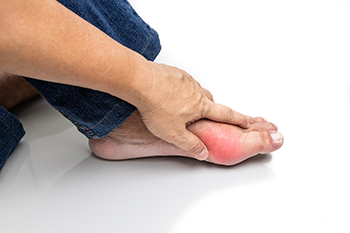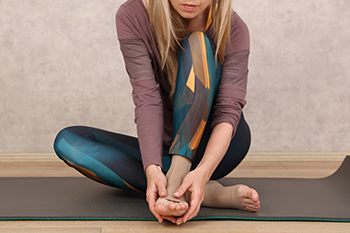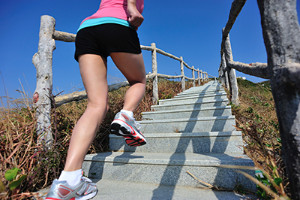Items filtered by date: March 2022
How Poor Circulation Can Affect Feet
When the heart pumps blood around the body, it is called circulation. Good blood circulation works to provide oxygen and nutrients to cells and remove waste from the body. Factors that can lead to poor circulation include high or low blood pressure, high red blood cells, a weak heart, and problems with veins and arteries interfering with the flow of blood to the body. Circulation can be improved by being more active, implementing cardiovascular and stretching exercises, and maintaining good health habits, like having a healthy body weight and not smoking. Other ways include reducing saturated fats, increasing omega-3 fatty acids and antioxidants in the diet, and having a balanced level of iron intake. Underlying conditions that can impact proper blood circulation include obesity, diabetes, and a heart condition. When one has poor circulation they may experience numbness, tingling, and pain in their limbs, including the feet. This can lead to falls or other conditions that can be dangerous and should be checked by a qualified podiatrist who can examine the feet, diagnose problems, and suggest proper treatment methods.
Poor circulation is a serious condition and needs immediate medical attention. If you have any concerns with poor circulation in your feet contact one of our podiatrists of Itasca Foot & Ankle. Our doctors will treat your foot and ankle needs.
Poor Circulation in the Feet
Poor blood circulation in the feet and legs is can be caused by peripheral artery disease (PAD), which is the result of a buildup of plaque in the arteries.
Plaque buildup or atherosclerosis results from excess calcium and cholesterol in the bloodstream. This can restrict the amount of blood which can flow through the arteries. Poor blood circulation in the feet and legs are sometimes caused by inflammation in the blood vessels, known as vasculitis.
Causes
Lack of oxygen and oxygen from poor blood circulation restricts muscle growth and development. It can also cause:
- Muscle pain, stiffness, or weakness
- Numbness or cramping in the legs
- Skin discoloration
- Slower nail & hair growth
- Erectile dysfunction
Those who have diabetes or smoke are at greatest risk for poor circulation, as are those who are over 50. If you have poor circulation in the feet and legs it may be caused by PAD and is important to make changes to your lifestyle in order to reduce risk of getting a heart attack or stroke. Exercise and maintaining a healthy lifestyle will dramatically improve conditions.
As always, see a podiatrist as he or she will assist in finding a regimen that suits you. A podiatrist can also prescribe you any needed medication.
If you have any questions please feel free to contact our offices located in Itasca and Hoffman Estates, IL . We offer the newest diagnostic and treatment technologies for all your foot and ankle needs.
Do You Suffer From Painful Feet?
Can Certain Medical Conditions Lead To Gout?
 Did you know gout is a form of arthritis? It is known to cause severe pain and discomfort, and it is often difficult to walk. It can develop as a result of excess uric acid that forms in the joints of the big toe. This can happen due to genetic reasons, or from eating foods that have high levels of purines. These types of foods can include shellfish, red meat, or it may come from drinking excessive amounts of alcohol. There may be existing medical conditions that can lead to the onset of gout, such as high blood pressure, diabetes, or kidney disorders. The symptoms that many patients experience can be tender joints in the big toe, excruciating pain, and the affected area is often tender and hot. If you have symptoms of gout, it is strongly advised that you are under the care of a podiatrist who can properly treat this condition.
Did you know gout is a form of arthritis? It is known to cause severe pain and discomfort, and it is often difficult to walk. It can develop as a result of excess uric acid that forms in the joints of the big toe. This can happen due to genetic reasons, or from eating foods that have high levels of purines. These types of foods can include shellfish, red meat, or it may come from drinking excessive amounts of alcohol. There may be existing medical conditions that can lead to the onset of gout, such as high blood pressure, diabetes, or kidney disorders. The symptoms that many patients experience can be tender joints in the big toe, excruciating pain, and the affected area is often tender and hot. If you have symptoms of gout, it is strongly advised that you are under the care of a podiatrist who can properly treat this condition.
Gout is a foot condition that requires certain treatment and care. If you are seeking treatment, contact one of our podiatrists from Itasca Foot & Ankle. Our doctors will treat your foot and ankle needs.
What Is Gout?
Gout is a type of arthritis caused by a buildup of uric acid in the bloodstream. It often develops in the foot, especially the big toe area, although it can manifest in other parts of the body as well. Gout can make walking and standing very painful and is especially common in diabetics and the obese.
People typically get gout because of a poor diet. Genetic predisposition is also a factor. The children of parents who have had gout frequently have a chance of developing it themselves.
Gout can easily be identified by redness and inflammation of the big toe and the surrounding areas of the foot. Other symptoms include extreme fatigue, joint pain, and running high fevers. Sometimes corticosteroid drugs can be prescribed to treat gout, but the best way to combat this disease is to get more exercise and eat a better diet.
If you have any questions please feel free to contact our offices located in Itasca and Hoffman Estates, IL . We offer the newest diagnostic and treatment technologies for all your foot and ankle needs.
Can I Run After Foot or Ankle Surgery?
Runners, especially those who run long distances regularly, often get injured. Serious injuries can lead to surgery, either on the foot or the ankle. The question of when you can safely resume running depends on the type of injury and the site of the surgery. For anyone who has had a total ankle joint replacement, for instance, running will most likely be prohibited. As for other injuries, you may not be able to reach the previous levels or length or frequency of running you once enjoyed. As a rule, it takes about one year to fully recover from major foot surgery, because of swelling, gait asymmetry, and reduced muscle strength. Eventually, you may be able to ease back into activity, if you run only on soft surfaces and wear shoes that adequately cushion your feet. To be on the safe side, it is a good idea to check in frequently with a podiatrist who can evaluate your healing progress and guide you on how far and how often you can safely run again.
Exercising your feet regularly with the proper foot wear is a great way to prevent injuries. If you have any concerns about your feet, contact one of our podiatrists of Itasca Foot & Ankle. Our doctors will treat your foot and ankle needs.
How to Prevent Running Injuries
Many common running injuries are caused by overuse and overtraining. When the back of the kneecap starts wearing out and starts causing pain in your knee, this is commonly referred to as runner’s knee. Runner’s knee is a decrease in strength in your quadriceps and can occur if you’re not wearing properly fitted or supporting shoes. To prevent runner’s knee, focusing on hip strengthening is a good idea, as well as strengthening your quads to keep the kneecaps aligned.
What Are Some Causes of Running Injuries?
- One cause of a common running injury is called iliotibial band syndrome.
- Plantar fasciitis is also another common injury.
- Stress fractures can occur from overtraining, lack of calcium, or even your running style.
Best Ways to Prevent Running Injuries
- Wear footwear that fits properly and suits your running needs.
- Running shoes are the only protective gear that runners have to safeguard them from injury.
- Make a training schedule. Adding strengthening exercises as well as regular stretching can help keep you strong and limber and can lessen the possibility of injuries.
- Stretching keeps muscles limber; this will help you gain better flexibility.
If you have any questions please feel free to contact our offices located in Itasca and Hoffman Estates, IL . We offer the newest diagnostic and treatment technologies for all your foot and ankle needs.
Top 9 Foot Care Tips for Elderly Adults
If you are a caregiver for an aging adult, helping them take care of their feet can help keep them healthy, active and improve their quality of life. Healthy feet can also help older adults avoid falls and broken bones. Here are the top nine things you can do to promote better foot health in an elderly person. 1) Inspect their feet daily for any redness, breaks in the skin or anything unusual. 2) Help them eat healthy foods, drink plenty of water, and engage in low impact exercise and stretching. 3) Trim their toenails straight across. 4) Make sure footwear fits properly, and have their feet measured for length and width every time they buy new shoes. 5) Don’t allow them to walk barefoot, even around the house. 6) Keep their feet clean, dry, and moisturized. 7) Make sure their socks are not tight to avoid cutting off circulation. 8) Never trim corns or calluses with a sharp instrument. 9) Have their feet checked regularly by a podiatrist, especially if they are diabetic.
If you need your feet checked, contact one of our podiatrists of Itasca Foot & Ankle. Our doctors will attend to all of your foot and ankle needs and provide you with quality treatment.
Geriatrics and Podiatry
When people age, some common issues that may occur are bone density loss, dry skin, poor circulation, and rough brittle nails. These issues may also affect your foot health if the necessary steps are not taken to alleviate the problems.
It is important to take care of your feet because feet that are injured or diseased can affect your overall health. Having painful feet hinders your ability to do daily activities or may decrease your willingness to do the things that you need to do.
Visiting Your Geriatrician
As we age, health problems become more likely, so it is essential to visit your doctor for check-ups to ensure that you are doing the best you can to take care of your health. It is recommended to check your feet frequently for any possible cuts, bruises, swelling, corns or any other irregularities.
Taking Care of Elderly Feet
Cracked or dry feet can be treated by applying moisturizer often. It is also important not to wear old socks because the older the sock is, the higher the possibility there will be that there is bacteria there. Wear fresh socks and make sure they fit properly.
Proper foot health means that you can have a more active lifestyle and you will not be bogged down by pain. Foot health also leads to good circulation, which is paramount for overall health.
If you have any questions, please feel free to contact our offices located in Itasca and Hoffman Estates, IL . We offer the newest diagnostic tools and technology to treat your foot and ankle needs.
What Are Orthotics Used For?
 Orthotics are designed to be inserted into shoes to help realign the feet or relieve pressure caused by other foot-related problems. They can also help with non-foot issues, such as knee pain or lower back pain. Orthotics can be made to take stress off certain parts of the feet, or to keep the feet aligned. Orthotics are also often used as a method to delay surgery (e.g., when a child needs to wait for their growth plates to close or for their bones to grow more) or to help alleviate pain after surgery. There are multiple ways to make orthotics as well. These methods include laser scanning the foot, using a foam box, or using a plaster cast. If you believe that orthotics are right for you, consulting with a podiatrist is suggested.
Orthotics are designed to be inserted into shoes to help realign the feet or relieve pressure caused by other foot-related problems. They can also help with non-foot issues, such as knee pain or lower back pain. Orthotics can be made to take stress off certain parts of the feet, or to keep the feet aligned. Orthotics are also often used as a method to delay surgery (e.g., when a child needs to wait for their growth plates to close or for their bones to grow more) or to help alleviate pain after surgery. There are multiple ways to make orthotics as well. These methods include laser scanning the foot, using a foam box, or using a plaster cast. If you believe that orthotics are right for you, consulting with a podiatrist is suggested.
If you are having discomfort in your feet and would like to try orthotics, contact one of our podiatrists from Itasca Foot & Ankle. Our doctors can provide the care you need to keep you pain-free and on your feet.
What Are Orthotics?
Orthotics are inserts you can place into your shoes to help with a variety of foot problems such as flat feet or foot pain. Orthotics provide relief and comfort for minor foot and heel pain but can’t correct serious biomechanical problems in your feet.
Over-the-Counter Inserts
Orthotics come in a wide variety of over-the-counter inserts that are used to treat foot pain, heel pain, and minor problems. For example, arch supports can be inserted into your shoes to help correct overarched or flat feet, while gel insoles are often used because they provide comfort and relief from foot and heel pain by alleviating pressure.
Prescription Orthotics
If over-the-counter inserts don’t work for you or if you have a more severe foot concern, it is possible to have your podiatrist prescribe custom orthotics. These high-quality inserts are designed to treat problems such as abnormal motion, plantar fasciitis, and severe forms of heel pain. They can even be used to help patients suffering from diabetes by treating foot ulcers and painful calluses and are usually molded to your feet individually, which allows them to provide full support and comfort.
If you are experiencing minor to severe foot or heel pain, it’s recommended to speak with your podiatrist about the possibilities of using orthotics. A podiatrist can determine which type of orthotic is right for you and allow you to take the first steps towards being pain-free.
If you have any questions please contact our offices located in Itasca and Hoffman Estates, IL . We offer the newest diagnostic and treatment technologies for all your foot and ankle needs.



